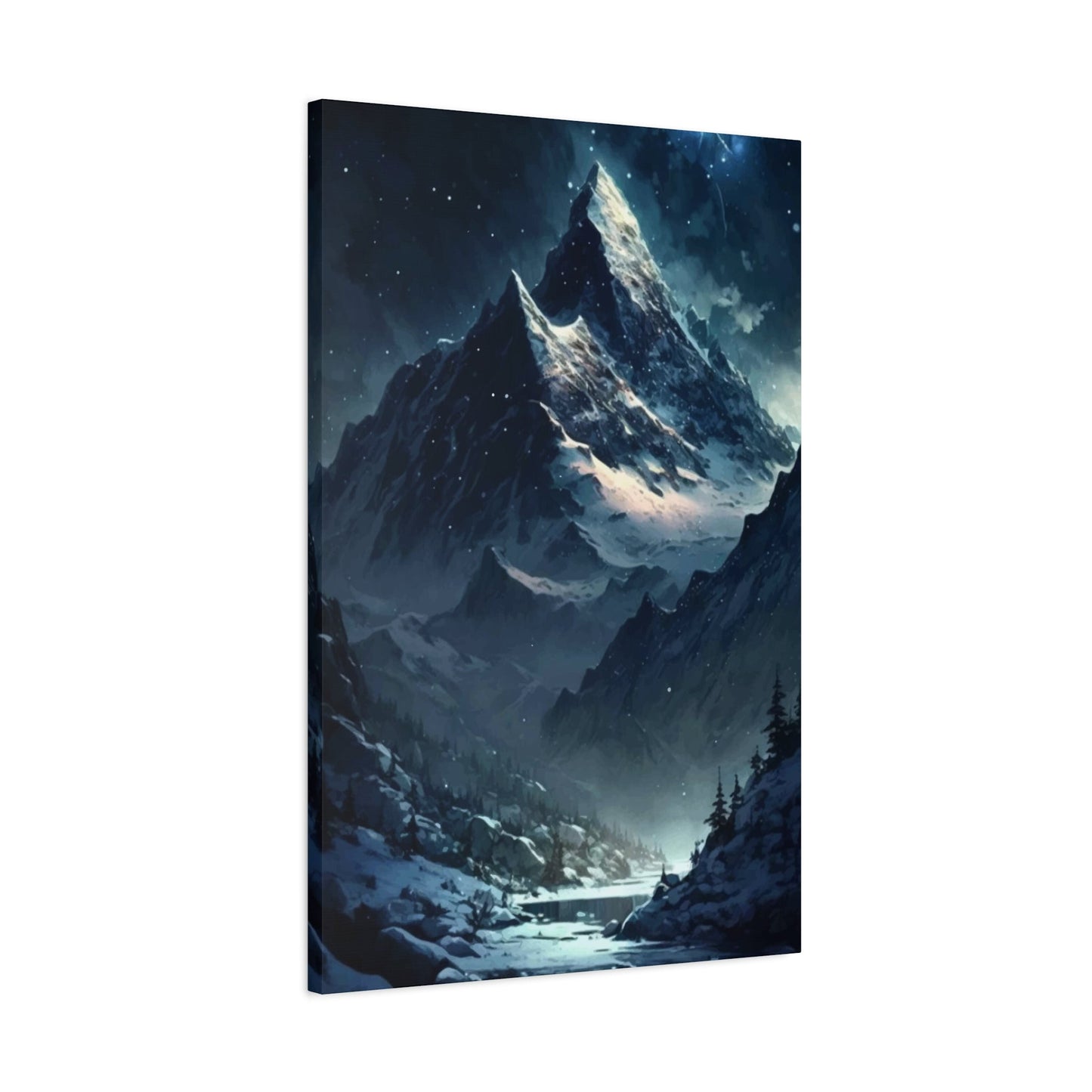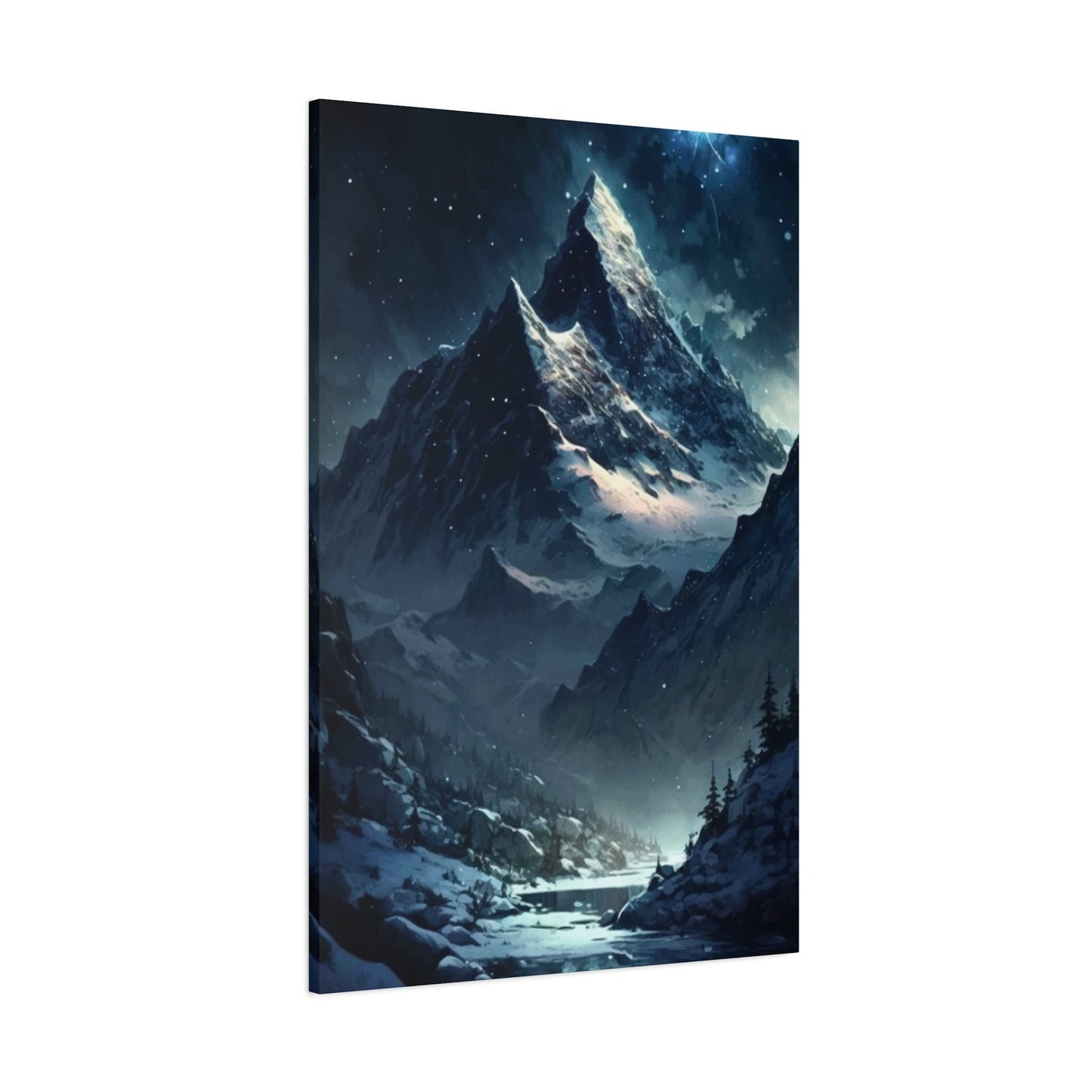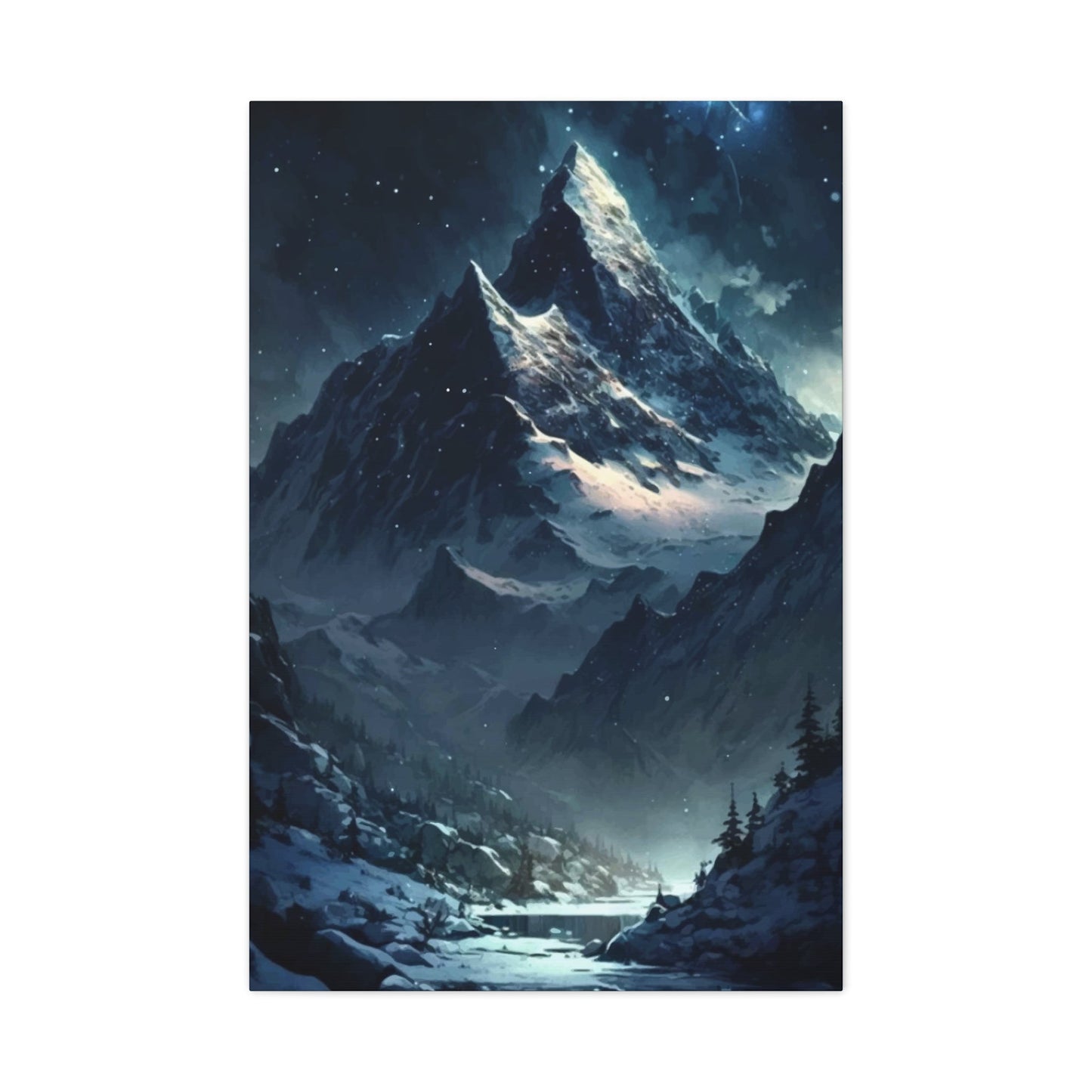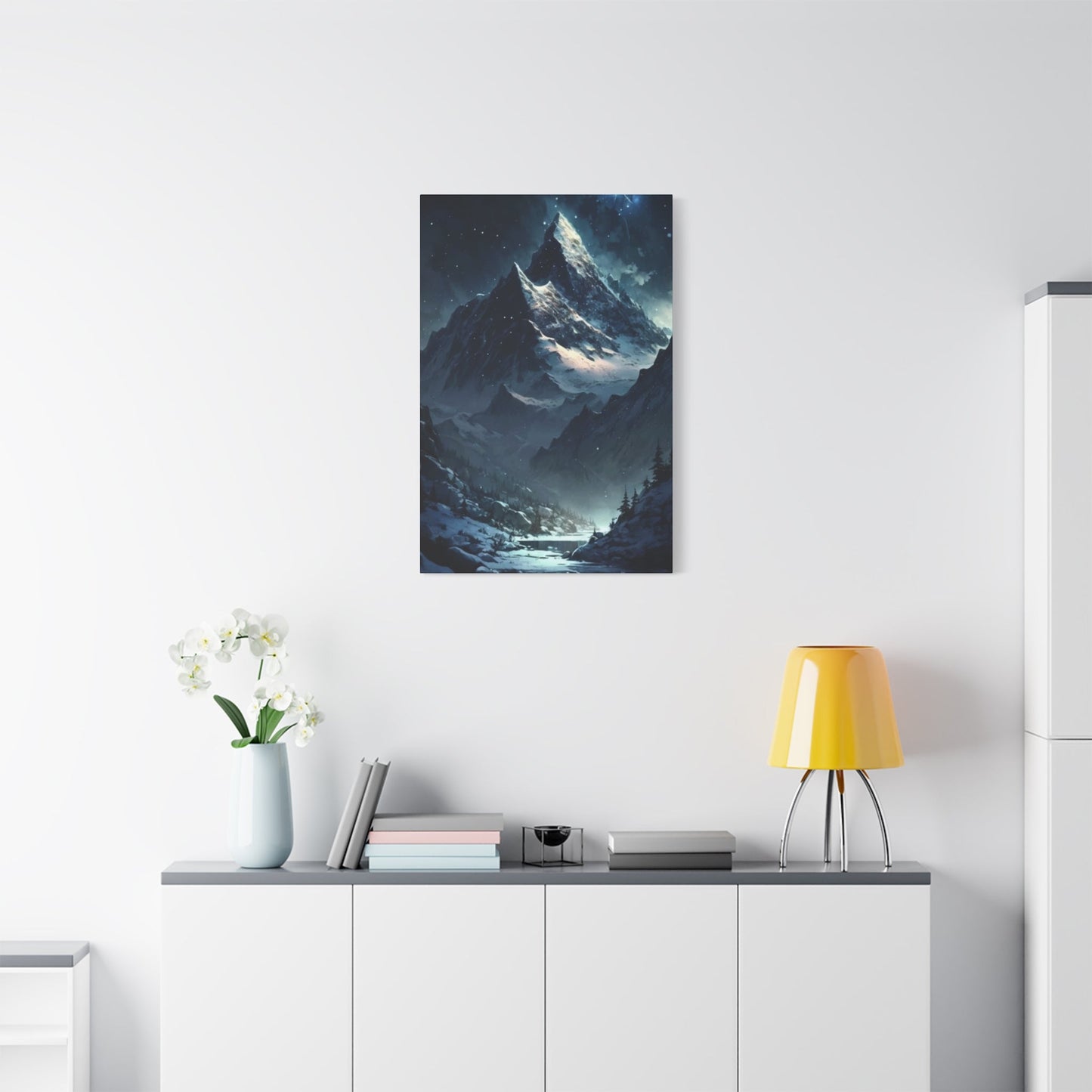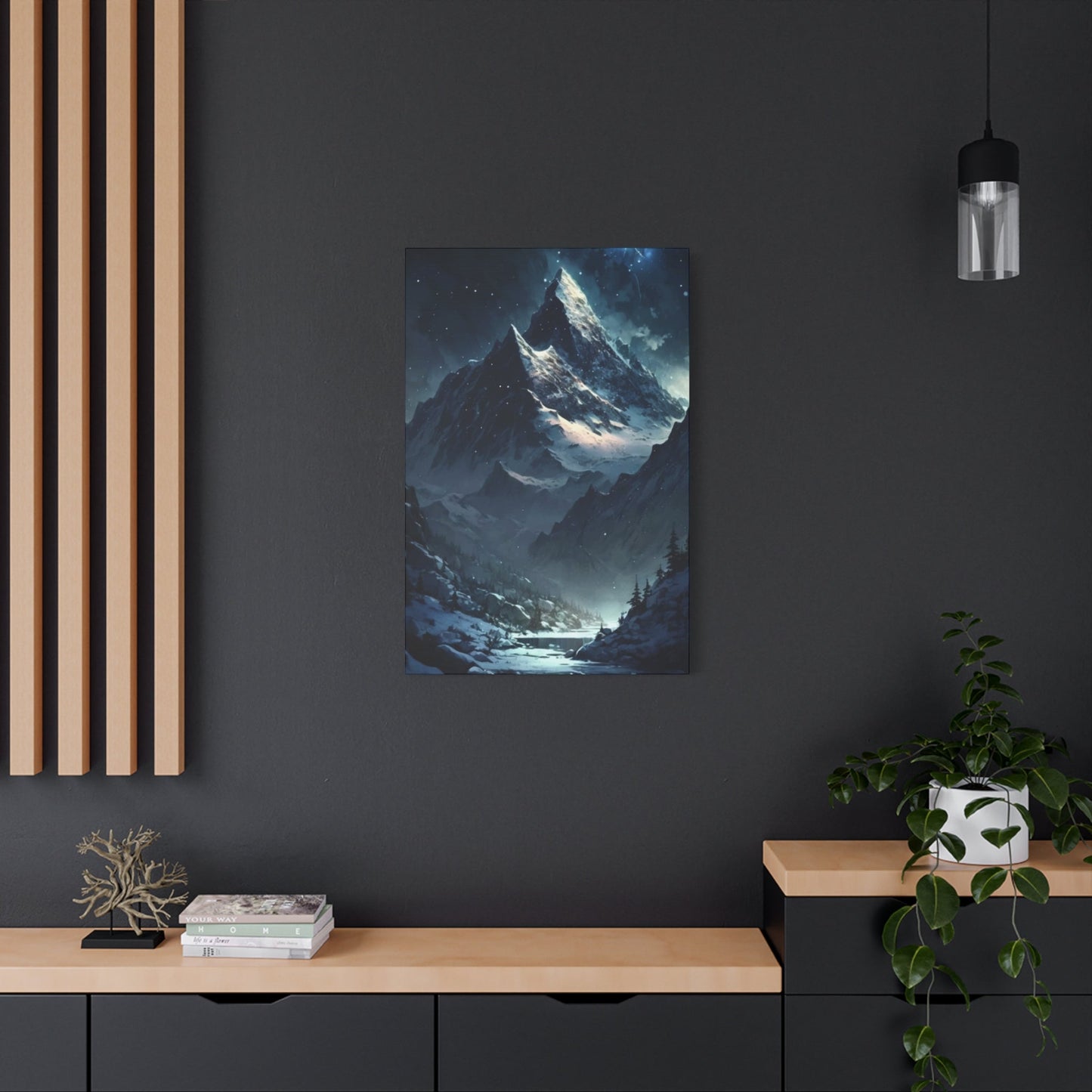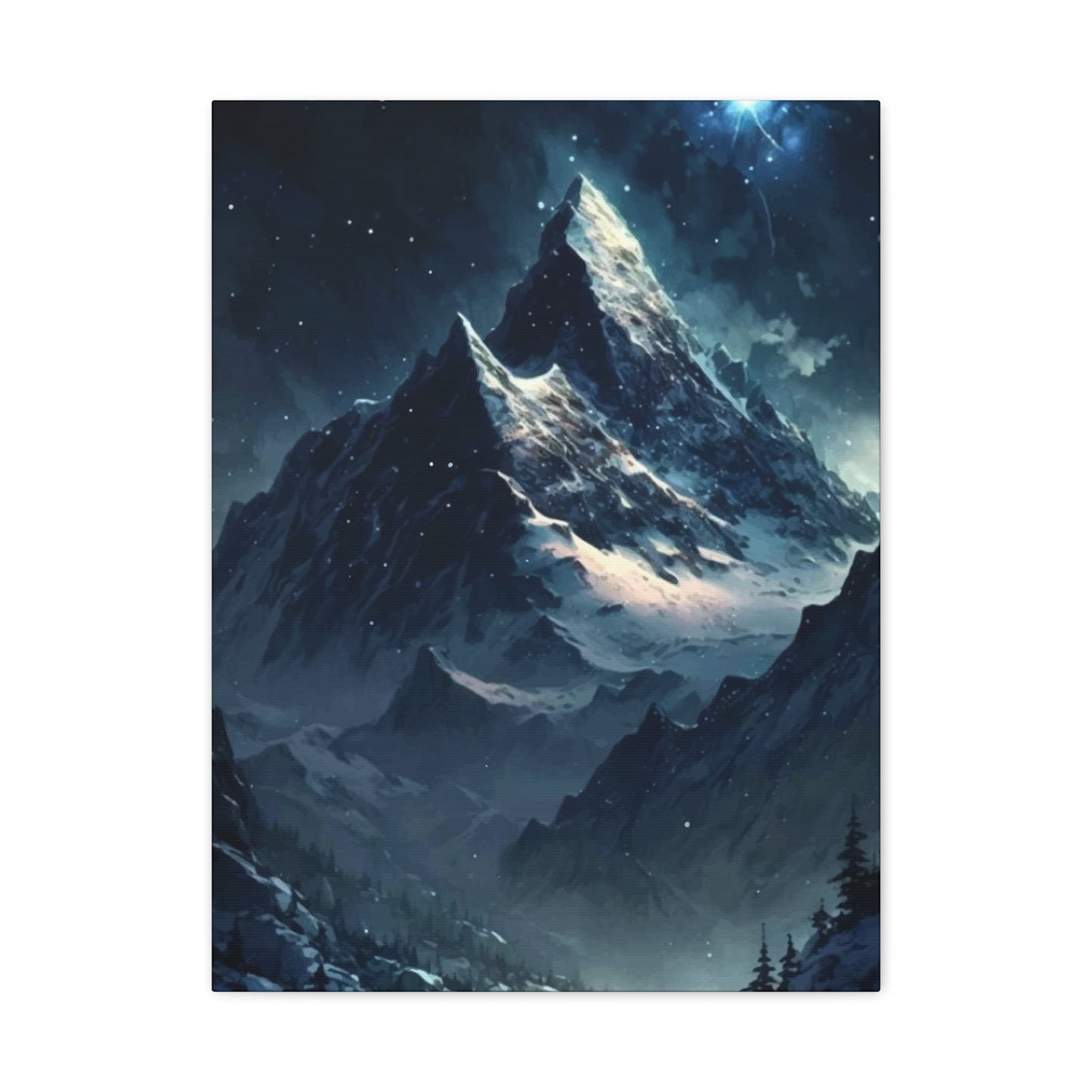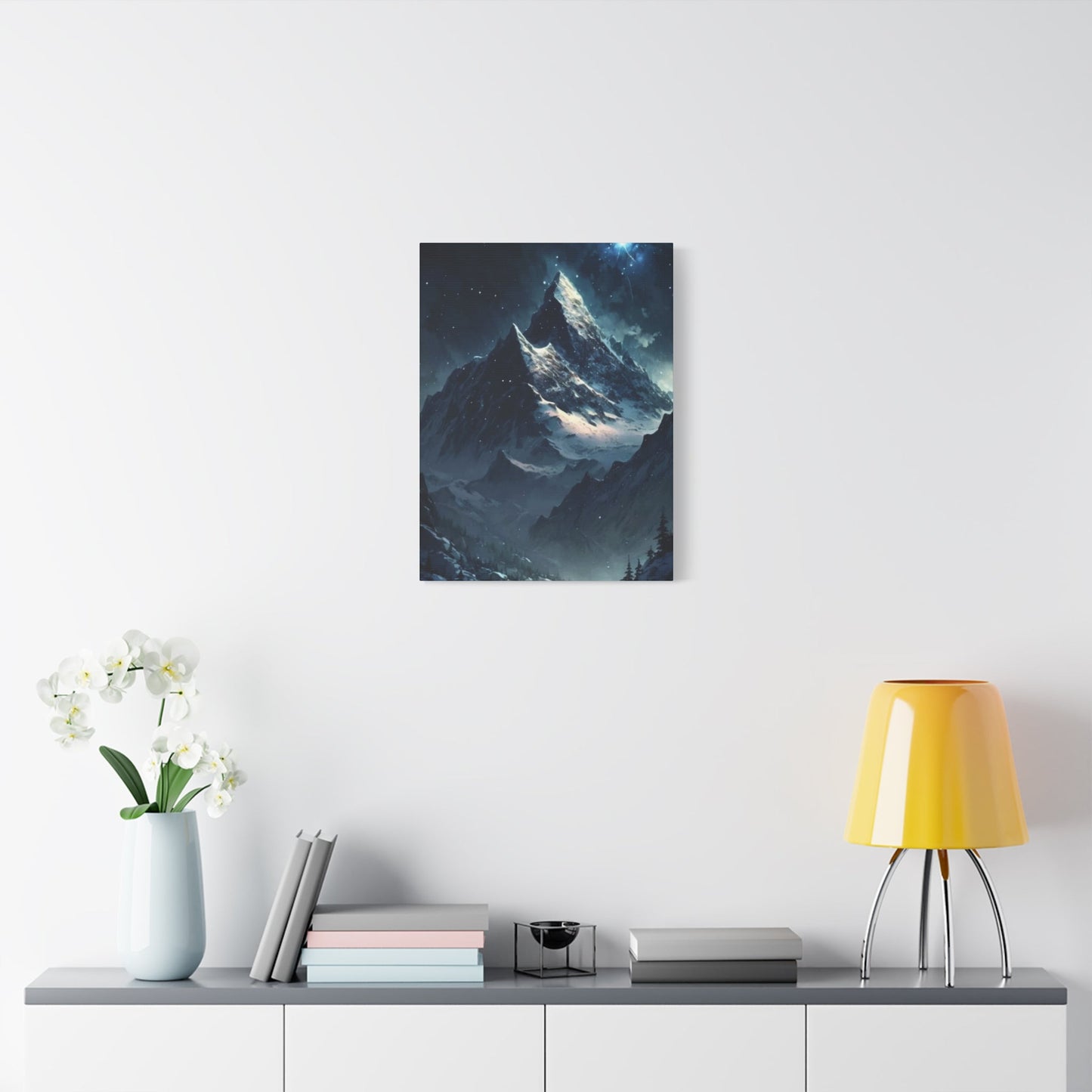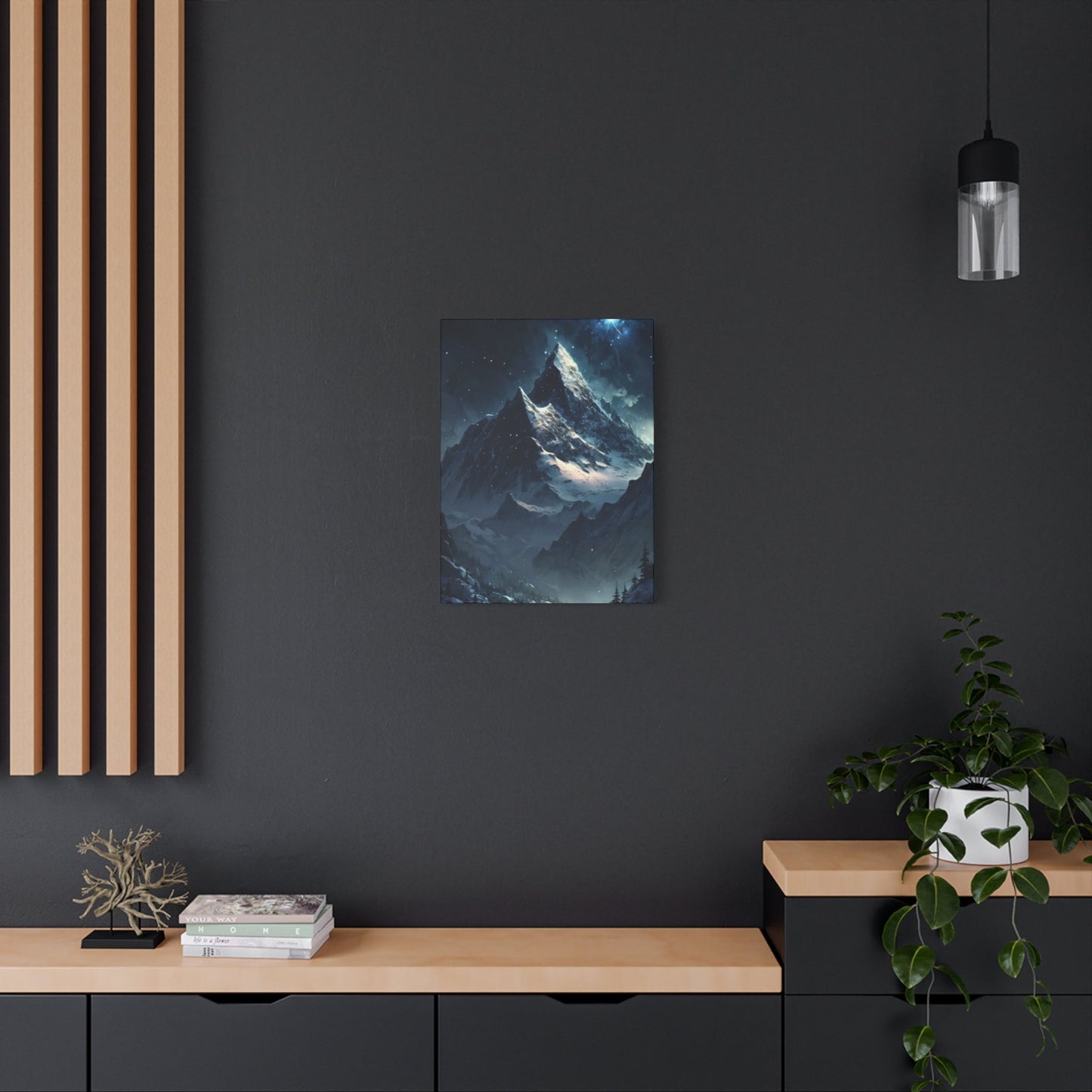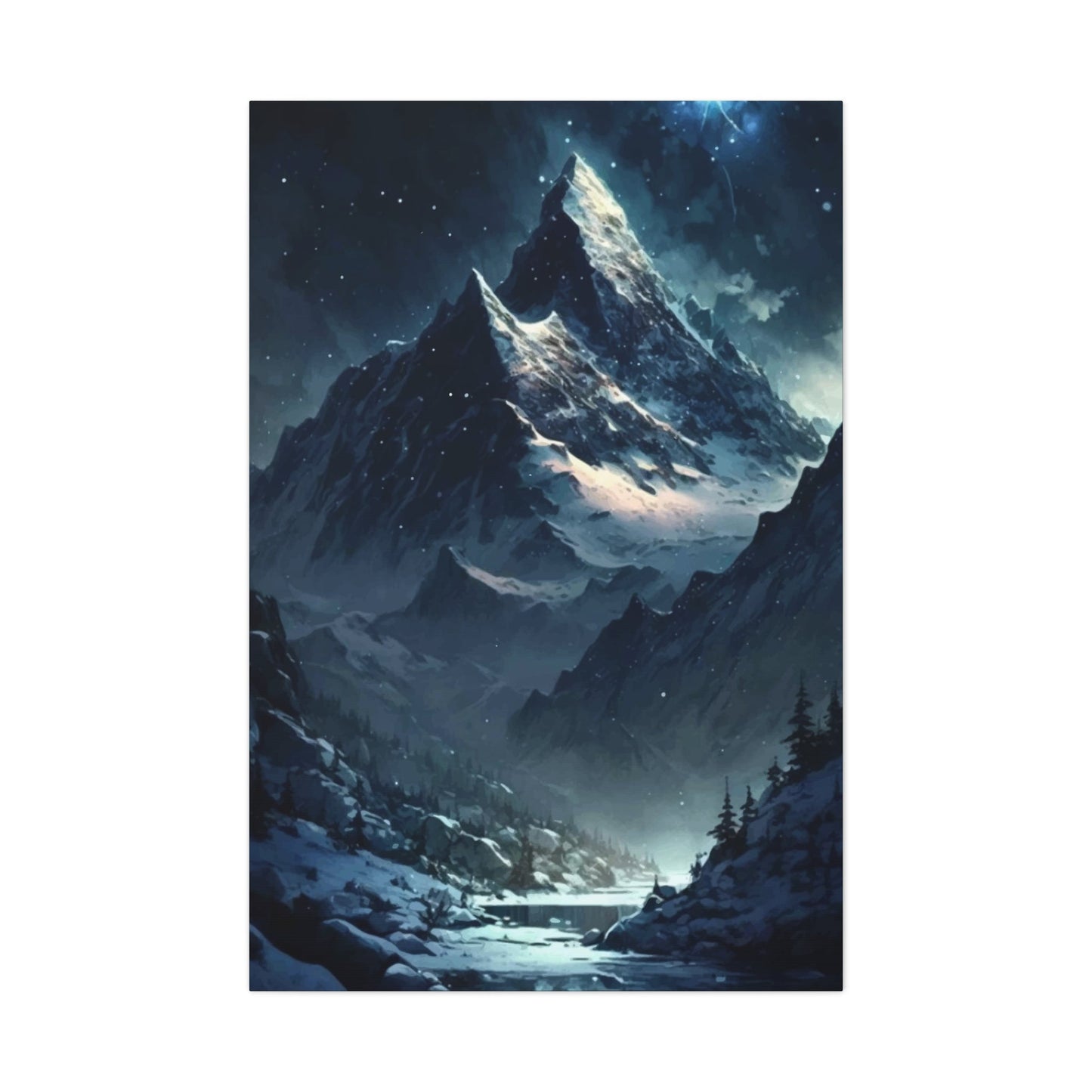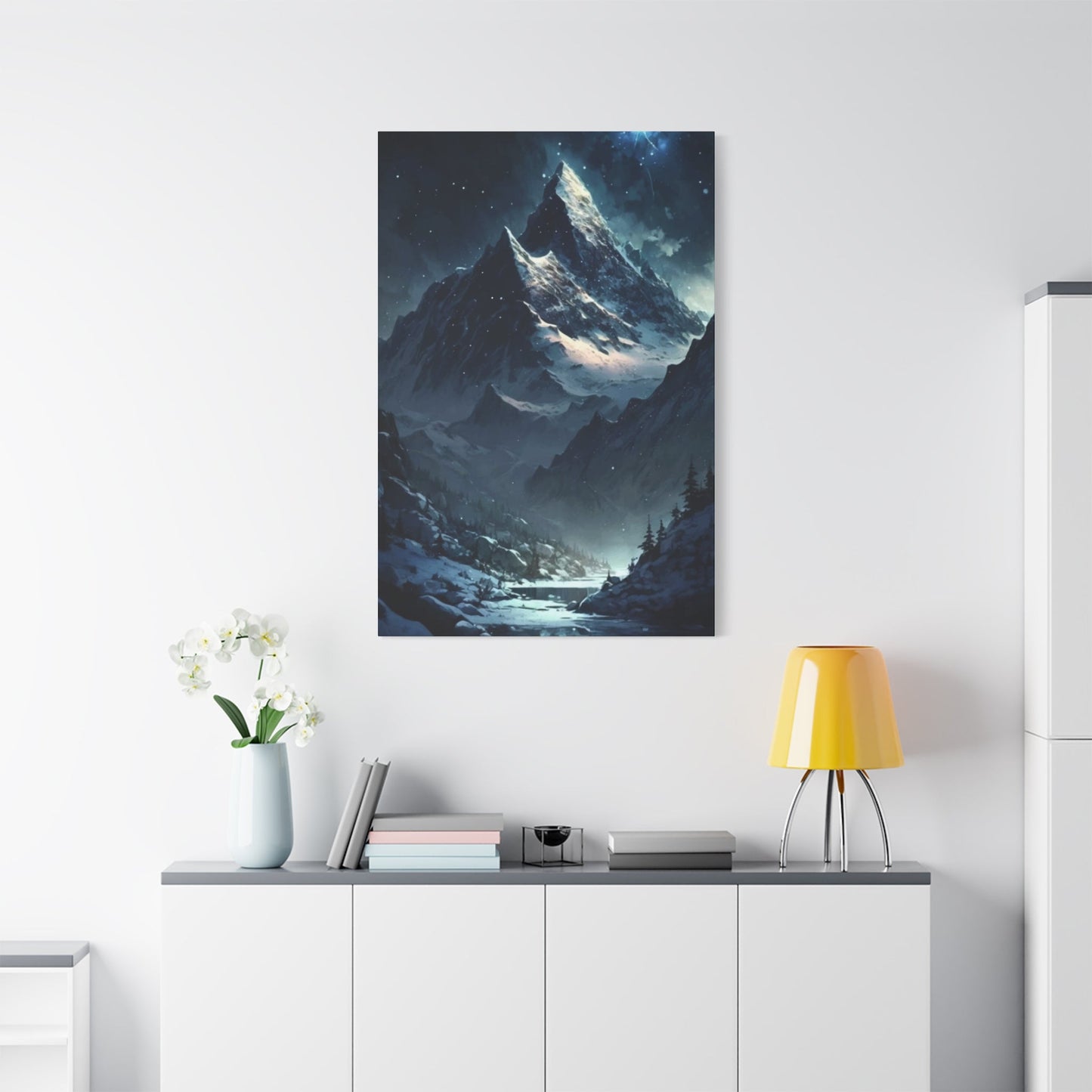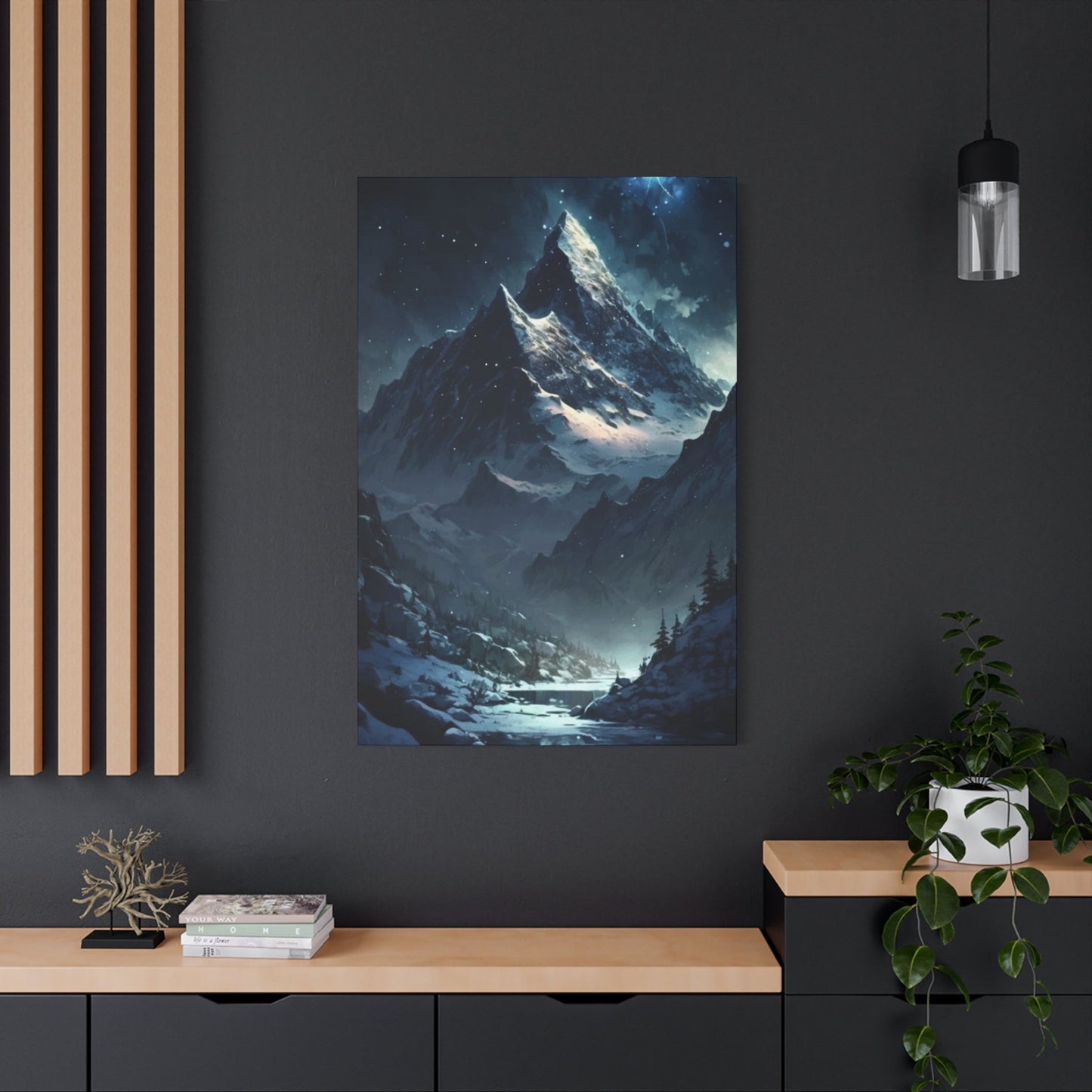Creating a Meditation Space with Dark Mountain Wall Art
Interior design enthusiasts and art collectors increasingly gravitate toward dark mountain art as a sophisticated means of transforming living spaces. These dramatic landscape pieces capture the raw beauty and mysterious allure of mountainous terrain through shadowy tones, deep contrasts, and atmospheric elements that evoke profound emotional responses. The growing popularity of moody mountain artwork reflects a broader design trend toward incorporating natural elements that speak to our innate connection with wilderness landscapes while adding depth and character to modern homes.
Dark mountain art encompasses various artistic mediums, from oil paintings and watercolors to digital prints and photography, all unified by their emphasis on dramatic lighting, stormy skies, and the imposing silhouettes of mountain ranges. These pieces serve as powerful focal points that can anchor entire room designs while creating conversations about nature's magnificent power and beauty. The versatility of dark mountain artwork allows it to complement diverse interior styles, from rustic cabin aesthetics to contemporary minimalist spaces.
Psychological Effects of Somber Mountain Scenes
The psychological impact of moody mountain landscapes extends far beyond mere aesthetic appreciation, tapping into deep-seated human emotions and primal connections to natural environments. These dark, atmospheric pieces often evoke feelings of solitude, contemplation, and introspection, creating spaces that encourage quiet reflection and mental restoration. The brooding quality of stormy mountain scenes can paradoxically provide comfort, as viewers find solace in the depicted wildness that mirrors their own complex emotional landscapes.
Research in environmental psychology suggests that exposure to natural imagery, particularly dramatic landscapes, can reduce stress levels and promote mental well-being. Dark mountain art specifically appeals to individuals who find peace in solitude and appreciate the raw, unfiltered beauty of nature's more challenging moods. The interplay of light and shadow in these pieces creates visual tension that keeps viewers engaged, while the mountainous subject matter provides a sense of permanence and stability that contrasts with the transient nature of modern life.
The color psychology behind dark mountain art reveals why these pieces resonate so deeply with viewers. Deep blues, charcoal grays, and rich blacks dominate these compositions, colors traditionally associated with depth, mystery, and sophistication. These hues create calming environments that promote focus and creativity, making dark mountain art particularly suitable for study areas, bedrooms, and meditation spaces. The occasional warm accent colors—perhaps a subtle sunrise glow or the golden light of late afternoon—provide emotional warmth that prevents the overall composition from feeling cold or unwelcoming.
Furthermore, the scale and grandeur depicted in mountain landscapes can help viewers gain perspective on their daily challenges. The overwhelming majesty of mountain ranges reminds us of our place within the broader natural world, often providing a sense of humility and grounding that proves therapeutic in our increasingly fast-paced society. This psychological anchoring effect makes dark mountain art particularly valuable in creating restorative environments within the home.
Harmonizing Shadowy Peaks with Earth-Toned Aesthetics
The successful integration of dark mountain art with earthy color palettes requires careful consideration of how various natural tones interact to create cohesive, visually appealing spaces. Earth tones—including warm browns, deep terracottas, muted ochres, and sage greens—provide the perfect complementary backdrop for dramatic mountain imagery, creating environments that feel both grounded and sophisticated. This pairing works exceptionally well because both elements draw inspiration from the natural world, creating a harmonious relationship that feels organic and intentional.
When selecting earth-toned elements to pair with dark mountain art, consider incorporating materials that reflect the rugged beauty of mountain environments. Rich leather furniture in cognac or deep brown hues echoes the earthiness of mountain terrain while providing comfortable seating that invites contemplation of the artwork. Natural wood elements, particularly those with prominent grain patterns or weathered finishes, add textural interest that complements the rocky surfaces depicted in mountain scenes.
Textile selections play a crucial role in creating successful earth-tone and dark mountain art combinations. Wool throws in heather gray, linen cushions in mushroom tones, and jute rugs provide tactile elements that reinforce the natural theme while adding layers of visual and physical comfort. These materials also help soften the sometimes stark contrast found in dramatic mountain imagery, creating spaces that feel welcoming rather than austere.
The strategic use of warm metallic accents can bridge the gap between dark mountain art and earth-tone furnishings. Copper picture frames, bronze lighting fixtures, and brass decorative objects add warmth and sophistication while referencing the mineral wealth often found in mountain regions. These metallic elements catch and reflect light, adding subtle sparkle that prevents earth-tone spaces from feeling flat or monotonous.
Color temperature considerations become particularly important when working with this palette combination. The cool tones often present in dark mountain art can be balanced with warm earth tones that have yellow or red undertones. This creates visual equilibrium that prevents the space from skewing too cool or too warm, resulting in environments that feel comfortable and inviting throughout different times of day and seasons.
Integrating Dark Mountain Imagery in Clean, Uncluttered Environments
Minimalist spaces provide an ideal canvas for showcasing dark mountain prints, as the clean, uncluttered aesthetic allows these dramatic pieces to command attention without competing with excessive decorative elements. The key to successfully incorporating mountain imagery into minimalist environments lies in treating the artwork as a statement piece that serves as the room's primary visual anchor. This approach requires careful consideration of scale, placement, and supporting elements to ensure the mountain art enhances rather than overwhelms the space.
Large-format mountain prints work exceptionally well in minimalist settings, as their substantial size creates impact while maintaining the clean lines that define this aesthetic. A single oversized mountain landscape can transform an entire wall into a window to the wilderness, providing visual depth and interest without requiring additional decorative elements. The negative space surrounding the artwork becomes an integral part of the composition, allowing the eye to rest while emphasizing the dramatic beauty of the mountain scene.
Color selection becomes critical when integrating dark mountain art into minimalist spaces. Black and white mountain photography or monochromatic paintings align perfectly with minimalist principles while providing the dramatic contrast that makes these pieces so compelling. The absence of bright colors maintains the serene quality essential to minimalist design while allowing the natural beauty of the mountain forms to speak for themselves.
Furniture selection in minimalist spaces featuring dark mountain art should emphasize clean lines and natural materials that complement the artwork without competing for attention. Low-profile sofas in neutral tones, sleek wooden coffee tables, and simple metal accent pieces create a sophisticated backdrop that allows the mountain imagery to remain the focal point. The furniture should appear to recede into the background, creating a sense of space and openness that mirrors the vast mountain landscapes depicted in the artwork.
Lighting considerations become particularly important in minimalist spaces featuring dark mountain art. Track lighting or picture lights can highlight the artwork while maintaining the clean aesthetic, while large windows or skylights can provide natural illumination that changes throughout the day, subtly altering how the mountain imagery appears. This dynamic lighting creates an ever-changing display that keeps the space feeling fresh and alive despite its minimal furnishings.
Non-Representational Mountain Forms in Deep Color Schemes
Abstract interpretations of mountain landscapes offer unique opportunities to incorporate the essence of mountainous terrain into interior spaces while maintaining artistic flexibility and personal expression. These non-representational pieces capture the emotional and spiritual qualities of mountain environments through color, form, and texture rather than literal depiction, allowing viewers to project their own experiences and emotions onto the artwork. This approach proves particularly effective in contemporary spaces where traditional landscape art might feel out of place.
The creation of abstract mountain art often involves layering techniques that build depth and complexity through multiple applications of paint or ink. Artists may begin with broad gestural strokes that suggest mountain silhouettes, then add layers of detail that create texture and visual interest without becoming literal representations. The resulting pieces maintain the power and majesty associated with mountain landscapes while offering the flexibility to complement diverse interior design schemes.
Color relationships in abstract mountain art often push beyond the natural palette found in traditional landscape painting, incorporating unexpected hues that evoke emotional responses rather than literal accuracy. Deep purples might represent the mystery of mountain twilight, while burnt oranges could capture the intensity of alpine sunsets. These color choices allow the artwork to serve as accent pieces that can tie together disparate design elements within a room while maintaining their connection to natural mountain themes.
Texture plays a particularly important role in abstract mountain interpretations, as artists can use impasto techniques, mixed media elements, and unusual materials to create surfaces that invite tactile exploration. Rough textures might represent rocky cliff faces, while smooth passages could suggest distant peaks shrouded in mist. This textural variety adds visual interest that keeps viewers engaged while providing sophisticated design elements that work well in contemporary spaces.
The scale and proportion of abstract mountain pieces can be manipulated to create dramatic impact or subtle accents, depending on the space and intended effect. Large abstract mountain works can serve as room-defining elements, while smaller pieces can be grouped to create compelling gallery walls. The non-representational nature of these pieces makes them particularly versatile for spaces where traditional landscape art might clash with existing design elements.
Surface Qualities in Mountain-Themed Canvas Artwork
Texture serves as a fundamental element in dark mountain canvas art, contributing significantly to the overall impact and emotional resonance of these pieces. The physical surface of the canvas becomes part of the artistic statement, with various application techniques creating tactile qualities that enhance the viewer's connection to the rugged mountain environments depicted. Artists employ multiple methods to achieve textural effects that complement and amplify the visual elements of their mountain compositions.
Impasto technique, where paint is applied thickly to create raised surfaces, proves particularly effective in mountain artwork as it can simulate the rough, weathered surfaces of rock formations. These heavily textured areas catch and reflect light differently throughout the day, creating subtle changes in appearance that keep the artwork dynamic and engaging. The three-dimensional quality of impasto work adds sculptural elements to paintings, making them more substantial presences within interior spaces.
Mixed media approaches allow artists to incorporate actual materials that reference mountain environments directly. Sand mixed with paint can create convincing representations of rocky surfaces, while small stones or mineral particles can add authentic textural elements that connect the artwork directly to its subject matter. These material additions create artwork that engages multiple senses, as viewers may be drawn to touch as well as observe the textured surfaces.
Brush technique variations contribute significantly to the textural vocabulary of mountain art. Dry brush techniques create rough, weathered effects that suggest eroded rock faces, while palette knife work can produce sharp, angular forms that emphasize the geometric aspects of mountain silhouettes. Cross-hatching and stippling techniques add subtle textural variations that build visual complexity without overwhelming the composition's overall coherence.
The canvas preparation process also affects the final textural quality of mountain artwork. Some artists choose to work on heavily textured canvases that provide an existing surface pattern, while others prefer smooth surfaces that allow complete control over textural elements. The choice of canvas texture interacts with paint application techniques to create unique surface qualities that become integral parts of the artistic statement.
Color interaction with textural elements creates additional complexity in mountain canvas art. Light colors applied over dark textured underpainting can create luminous effects that suggest atmospheric conditions, while dark colors worked into textured surfaces can create deep shadows that add dramatic contrast. These color and texture relationships require careful balance to avoid overwhelming the composition while maximizing visual impact.
Rustic Lodge Aesthetics and Dark Mountain Artwork
Dark mountain art finds its most natural home within cabin decor schemes, where the rugged beauty of mountain landscapes complements the warm, rustic elements that define this popular interior style. The integration of dramatic mountain imagery into cabin environments creates cohesive design narratives that celebrate humanity's relationship with wilderness settings. These spaces feel authentic and welcoming while maintaining the sophisticated visual impact that quality mountain art provides.
Natural wood elements form the foundation of successful cabin decor schemes featuring dark mountain art. Exposed beam ceilings, knotty pine paneling, and reclaimed wood furniture create textural backgrounds that complement the rugged qualities depicted in mountain scenes. The warm tones of natural wood provide visual balance for the often cool color palettes found in mountain artwork, creating environments that feel both dramatic and comfortable.
Stone and rock elements add authentic mountain lodge atmosphere while providing textural variety that enhances the overall design scheme. River rock fireplaces, flagstone flooring, and stone accent walls create connections between the mountain imagery and the physical space, making the artwork feel like a natural extension of the room's architectural elements. These materials also add thermal mass that helps regulate temperature, creating comfortable environments perfect for contemplating mountain vistas.
Lighting design in cabin spaces featuring dark mountain art requires careful consideration of both functional and aesthetic needs. Warm, ambient lighting from table lamps with fabric shades creates cozy atmosphere while allowing the mountain artwork to remain visible and impactful. Picture lighting or track systems can highlight specific pieces while maintaining the warm, welcoming quality essential to cabin aesthetics.
Textile selections for cabin spaces should emphasize natural materials and earth-tone colors that support both the rustic aesthetic and the mountain art. Wool blankets, leather cushions, and linen curtains add comfort and visual warmth while maintaining the connection to natural materials. These textiles also help absorb sound, creating quiet spaces perfect for relaxation and contemplation of mountain scenery.
Furniture arrangements in cabin spaces should promote gathering and conversation while allowing optimal viewing of mountain artwork. Comfortable seating arranged around focal points like fireplaces creates intimate environments where the mountain art becomes part of the social experience. Coffee tables made from reclaimed wood or natural stone provide surfaces for books, beverages, and decorative objects that reinforce the mountain theme.
Composing Multi-Piece Mountain Art Displays
Creating gallery walls with mountain-themed prints requires careful planning and artistic vision to achieve arrangements that feel intentional and visually coherent. The process involves balancing various elements including scale, color, subject matter, and spacing to create displays that enhance rather than overwhelm interior spaces. Successful mountain art gallery walls tell visual stories that guide viewers through carefully orchestrated compositions while maintaining individual piece integrity.
Scale relationships between pieces form the foundation of effective gallery wall design. Mixing large statement pieces with smaller supporting works creates visual hierarchy that prevents walls from appearing cluttered or chaotic. A large mountain landscape might serve as the anchor piece, with smaller studies or detail shots arranged around it to create supporting visual elements. This approach allows viewers to take in the overall composition while discovering individual pieces through closer examination.
Color coordination across multiple mountain pieces requires subtle handling to avoid creating monotonous displays. While maintaining tonal consistency helps unify the arrangement, introducing pieces with slightly different color temperatures or seasonal variations adds visual interest and prevents the display from feeling flat. A gallery wall might feature predominantly cool-toned winter mountain scenes punctuated by warmer autumn or sunset pieces that add visual warmth and variety.
Spacing considerations significantly impact the success of mountain art gallery walls. Pieces hung too close together compete for attention and create visual confusion, while excessive spacing makes the arrangement feel disconnected and scattered. The optimal spacing typically ranges from two to four inches between frames, with adjustments made based on the specific pieces and wall size. Consistent spacing creates rhythm and unity across the display.
Frame selection and consistency contribute to the professional appearance of mountain art gallery walls. While frames need not be identical, maintaining consistency in material, color, or style helps unify diverse pieces into coherent displays. Simple black or natural wood frames typically work well with mountain imagery, allowing the artwork to remain the focus while providing necessary visual structure.
Installation techniques for gallery walls require careful planning and often benefit from creating paper templates before committing to wall placement. Arranging pieces on the floor allows experimentation with different configurations before making permanent decisions. Starting with the largest or most important piece and building the arrangement around it typically produces more successful results than attempting to design the entire wall simultaneously.
Symbolism of Power and Endurance in Mountain Art
Dark mountain art serves as a powerful symbol of strength and resilience, tapping into archetypal human associations between mountainous landscapes and qualities of endurance, permanence, and unwavering determination. Throughout human history, mountains have represented challenges to overcome, heights to achieve, and solid foundations upon which to build. These symbolic associations make mountain artwork particularly meaningful for individuals seeking to create environments that reinforce personal strength and resilience.
The visual metaphors present in mountain imagery resonate deeply with viewers who face their own challenges and obstacles. The towering peaks depicted in dark mountain art can represent goals to achieve or difficulties overcome, while the solid mass of the mountains themselves suggests the kind of unshakeable foundation that supports lasting success. These symbolic elements make mountain art particularly appropriate for spaces where individuals seek motivation and inspiration.
Cultural associations with mountains span virtually every civilization, with these elevated landscapes often representing spiritual transcendence, wisdom, and connection to divine forces. Dark mountain art can tap into these deeper cultural meanings, creating spaces that feel spiritually significant without requiring specific religious symbolism. The universal nature of mountain symbolism makes these pieces accessible to viewers from diverse backgrounds and belief systems.
The contrast between light and shadow often present in dark mountain art adds layers of symbolic meaning related to life's challenges and triumphs. Dramatic lighting effects can suggest hope emerging from difficulty, while shadowy passages might represent the unknown challenges that make achievements meaningful. These visual metaphors create artwork that functions on multiple levels, providing both aesthetic pleasure and deeper emotional resonance.
Seasonal symbolism in mountain art adds temporal dimensions to these symbolic meanings. Snow-covered peaks might represent purity and new beginnings, while autumn mountain scenes could suggest the wisdom that comes with experience and maturity. These seasonal variations allow collectors to choose pieces that resonate with their current life circumstances or aspirational goals.
The permanent, unchanging quality of mountains provides symbolic comfort in an era of rapid change and uncertainty. Mountain art can create environments that feel stable and enduring, offering psychological anchoring in spaces where individuals need to feel grounded and secure. This symbolic stability makes mountain artwork particularly valuable in bedrooms, studies, and other personal retreat spaces.
Capturing Time's Passage in Mountain Artwork
Seasonal changes captured in dark mountain artwork provide dynamic visual narratives that reflect the passage of time and the cyclical nature of natural processes. These temporal elements add depth and meaning to mountain art collections, allowing viewers to experience the full range of mountain moods and atmospheric conditions throughout the year. Artists who specialize in seasonal mountain imagery understand how changing light, weather, and vegetation create dramatically different emotional impacts within similar compositional frameworks.
Winter mountain scenes in dark palettes emphasize the stark beauty of snow-covered peaks against stormy skies, creating compositions that feel both serene and dramatic. The contrast between white snow and dark rock creates natural chiaroscuro effects that add visual interest while emphasizing the sculptural qualities of mountain forms. These winter scenes often evoke feelings of solitude and contemplation, making them particularly suitable for quiet spaces designed for reflection and rest.
Spring mountain imagery captures the renewal and awakening that characterizes this transitional season, often featuring emerging vegetation and dramatic weather patterns as winter gives way to warmer conditions. The subtle greens and earth tones of spring growth provide color accents that enliven otherwise monochromatic mountain compositions. These pieces work well in spaces where occupants seek inspiration and motivation for new projects or life changes.
Summer mountain scenes offer opportunities to explore the full range of mountain ecosystems, from alpine meadows to dense forests that clothe lower mountain slopes. The lush vegetation of summer provides textural and color contrasts that create visually rich compositions while maintaining the dramatic impact associated with mountain landscapes. These warmer season pieces can add welcome color and life to interior spaces dominated by cooler tones.
Autumn mountain artwork showcases nature's most dramatic color transformations, as deciduous trees create brilliant displays against the permanent backdrop of stone peaks. The warm colors of autumn foliage provide natural accent tones that can coordinate with interior design elements while maintaining the sophisticated impact of mountain imagery. These pieces often evoke nostalgia and appreciation for natural beauty's transient nature.
The technical challenges of capturing seasonal changes in mountain artwork require artists to understand how atmospheric conditions affect light, color, and visibility at different times of year. Atmospheric perspective changes dramatically with seasonal weather patterns, creating different levels of clarity and color saturation that artists must master to create convincing seasonal representations. These technical considerations contribute to the overall impact and authenticity of seasonal mountain artwork.
Sizing Considerations for Mountain Print Selections
Choosing the appropriate size for mountain prints requires careful consideration of multiple factors including room dimensions, wall space, viewing distance, and the intended impact of the artwork within the space. The scale of mountain imagery can dramatically affect its emotional impact, with larger pieces creating immersive experiences that transport viewers into the depicted landscape, while smaller works provide intimate viewing experiences that reward close examination and contemplation.
Room size and ceiling height significantly influence optimal print dimensions for mountain artwork. Large rooms with high ceilings can accommodate substantial prints that might overwhelm smaller spaces, while intimate rooms often benefit from smaller pieces that maintain appropriate scale relationships. The goal is to create visual balance where the artwork enhances rather than dominates the space, contributing to overall design harmony while providing meaningful focal points.
Viewing distance affects how much detail viewers can appreciate in mountain prints, influencing decisions about both size and image complexity. Prints intended for close viewing can include intricate details that reward examination, while pieces designed to be viewed from across a room should emphasize bold compositions and clear tonal relationships that remain impactful at distance. Understanding intended viewing scenarios helps ensure print sizes will achieve their desired effects.
Wall space considerations extend beyond simple measurement to include factors like window placement, furniture arrangements, and architectural features that affect available display area. A mountain print must fit not just physically but visually within its intended location, leaving appropriate margins and maintaining pleasing relationships with surrounding elements. Template creation using paper cutouts can help visualize how different sizes will work within specific spaces.
Multiple print arrangements require different size considerations than single statement pieces, as the relationship between prints becomes an important design element. Gallery walls might feature varying sizes that create visual rhythm and hierarchy, while diptych or triptych arrangements typically work best with matching dimensions that create unified compositions. The spacing between multiple prints also affects how size relationships are perceived.
Budget considerations often influence size decisions for mountain prints, as larger formats typically require higher investments in both printing and framing costs. However, the visual impact per dollar often favors larger prints that create substantial presence within interior spaces. Balancing budget constraints with desired visual impact requires careful consideration of priorities and long-term satisfaction with the chosen pieces.
Monochromatic Mountain Photography for Interior Design
Black and white dark mountain photography offers timeless elegance and sophisticated visual impact that transcends temporary design trends while providing maximum flexibility for integration into diverse interior schemes. The absence of color allows these pieces to focus entirely on form, texture, light, and composition, creating artwork that feels both contemporary and classic. Monochromatic mountain images work particularly well in spaces where color coordination might be challenging or where the emphasis should remain on architectural elements and furnishings.
The technical mastery required for successful black and white mountain photography involves understanding how different colors translate to grayscale values and how to manipulate contrast to create compelling compositions. Photographers must pre-visualize how colored elements will appear in monochrome, often using filters and post-processing techniques to achieve optimal tonal relationships. The resulting images often possess greater emotional impact than their color counterparts due to the elimination of potentially distracting color elements.
Contrast relationships in black and white mountain photography create dramatic visual tension that keeps viewers engaged while emphasizing the sculptural qualities of mountain forms. The interplay between pure whites, rich blacks, and subtle gray tones creates depth and dimension that can make flat prints appear three-dimensional. These tonal relationships also allow black and white mountain prints to work effectively with both light and dark interior color schemes.
Texture reproduction in monochromatic mountain photography often appears enhanced compared to color versions, as viewers focus more intently on surface qualities when color distractions are eliminated. The rough textures of rock faces, the smooth gradations of misty atmospheres, and the sharp details of snow and ice all become more prominent in black and white presentations. This emphasis on texture makes these prints particularly effective in minimalist spaces where tactile qualities contribute significantly to overall design impact.
Framing and presentation options for black and white mountain photography range from traditional to contemporary, with choices significantly affecting the final visual impact. Simple black frames create sophisticated, gallery-like presentations that emphasize the artwork's fine art qualities, while natural wood frames add warmth that prevents monochromatic images from feeling cold or sterile. Matting choices also influence presentation, with white mats creating clean, contemporary looks while gray or cream mats add subtle warmth.
The psychological impact of black and white mountain photography often differs from color mountain art, with monochromatic images typically feeling more contemplative and timeless. The absence of color can make these pieces feel more universal and less tied to specific locations or time periods, allowing viewers to project their own experiences and emotions onto the imagery more readily. This quality makes black and white mountain prints particularly effective in spaces designed for meditation, study, or quiet reflection.
National Park Inspirations in Dark Mountain Artwork
Dark mountain art inspired by national parks captures the preserved wilderness areas that represent some of Earth's most spectacular mountain landscapes, translating these protected environments into artwork that brings their majesty into interior spaces. Artists who focus on national park subjects often develop deep relationships with specific locations, returning repeatedly to capture different seasons, lighting conditions, and atmospheric moods that reveal the full character of these remarkable places.
The Grand Canyon's layered rock formations provide endless inspiration for artists exploring dark mountain themes, with the deep shadows and dramatic lighting of canyon environments creating natural chiaroscuro effects. The scale and geological complexity of this landscape translate beautifully into artwork that emphasizes both the power and ancient history of mountain formation processes. Artists often focus on the interplay between light and shadow that makes canyon landscapes so visually compelling throughout different times of day.
Yosemite's granite monoliths and dramatic waterfalls offer subjects that combine the solid permanence of mountain forms with the dynamic movement of cascading water. The contrast between these elements creates visual tension that keeps viewers engaged while celebrating the diverse beauty found within mountain ecosystems. Dark interpretations of Yosemite landscapes often emphasize the imposing scale of formations like Half Dome and El Capitan, creating artwork that conveys both beauty and raw power.
Rocky Mountain National Park provides inspiration for artists interested in alpine environments and the unique atmospheric conditions found at high elevations. The thin air and intense UV radiation at altitude create distinctive lighting effects and color relationships that artists must understand to capture authentic mountain atmosphere. The dramatic weather changes common in high mountain environments offer constantly changing subjects for artistic interpretation.
Glacier National Park's combination of mountain peaks, pristine lakes, and ancient ice formations creates complex compositions that challenge artists to balance multiple landscape elements. The deep blues of glacial lakes provide color accents that can enliven otherwise monochromatic mountain compositions, while the textural variety of ice, rock, and water creates visually rich artwork that rewards extended viewing.
The conservation message inherent in national park-inspired art adds meaning and purpose beyond aesthetic considerations. These pieces serve as reminders of the importance of preserving wilderness areas while bringing awareness of these magnificent landscapes to viewers who may never have the opportunity to visit them in person. This environmental consciousness adds depth and significance to national park mountain art that resonates with environmentally aware collectors.
Current Trends in Atmospheric Landscape Art
The popularity of moody landscapes in contemporary wall art reflects broader cultural trends toward authenticity, connection with nature, and appreciation for atmospheric beauty that transcends literal representation. Modern consumers increasingly seek artwork that provides emotional resonance and personal meaning rather than simple decorative function, leading to growing demand for landscape pieces that capture specific moods and atmospheric conditions rather than merely depicting scenic locations.
Social media platforms have significantly influenced the popularity of moody landscape art, as dramatically lit mountain scenes and atmospheric conditions photograph well and generate strong engagement from viewers. The "Instagrammable" quality of moody landscapes has introduced these aesthetic sensibilities to broader audiences who might not traditionally collect landscape art. This social media influence has also led to increased appreciation for the technical skills required to capture and reproduce atmospheric effects in various artistic media.
Interior design trends favoring natural materials, earth tones, and biophilic design principles have created ideal environments for moody landscape art integration. The movement toward creating interior spaces that connect occupants with natural environments aligns perfectly with atmospheric mountain artwork that brings wilderness beauty indoors. This trend extends beyond mere decoration to encompass wellness-focused design that recognizes art's role in creating psychologically beneficial environments.
The minimalist movement's emphasis on quality over quantity has elevated standards for landscape art, with collectors preferring fewer, higher-quality pieces that provide lasting satisfaction over temporary decorative solutions. This shift has benefited atmospheric landscape artists whose work offers the depth and complexity that rewards extended viewing and contemplation. The investment mentality toward art acquisition has also increased appreciation for original works and limited edition prints over mass-produced decorative pieces.
Commercial interior design applications have embraced moody landscape art for its ability to create sophisticated, welcoming environments in hotels, restaurants, offices, and healthcare facilities. The universal appeal of mountain landscapes and their association with strength, stability, and natural beauty make these pieces ideal for commercial spaces where diverse audiences must feel comfortable and welcome. The psychological benefits of nature imagery in commercial environments have been well-documented, leading to increased professional demand for quality landscape art.
The sustainability movement has influenced landscape art popularity as consumers seek to support artists who celebrate and advocate for natural environment preservation. Collectors increasingly value artwork that carries environmental messages and supports conservation efforts, leading to greater appreciation for landscape artists who donate portions of their proceeds to environmental organizations or who use sustainable materials and processes in their work.
Enhancing Dark Mountain Art with Metallic Elements
Combining dark mountain art with metallic accents creates sophisticated interior designs that balance the organic beauty of mountain landscapes with the refined elegance of precious metals. This combination works particularly well because metallic elements can reference the mineral wealth often found in mountain regions while adding sparkle and light that prevents dark artwork from overwhelming interior spaces. The key to success lies in selecting metallic finishes and objects that complement rather than compete with the mountain imagery.
Copper accents provide warm, earth-toned metallic elements that harmonize beautifully with the natural subjects and often warm undertones found in mountain artwork. Copper picture frames, light fixtures, and decorative objects add rich color that coordinates with autumn mountain scenes while providing the durability and patina development that adds character over time. The living finish of copper creates dynamic elements that change appearance as they age, paralleling the natural processes depicted in mountain landscapes.
Brass elements offer golden warmth that can brighten spaces featuring dark mountain art while maintaining sophisticated appeal. Brass sconces positioned to highlight mountain prints create functional lighting solutions that double as decorative elements, while brass furniture hardware and accessories add subtle luxury touches throughout the space. The traditional associations of brass with quality craftsmanship align well with the timeless appeal of mountain landscape art.
Iron and steel accents provide industrial contrast that can enhance contemporary interpretations of mountain themes while adding structural elements that reference the geological forces that create mountain formations. Wrought iron candle holders, steel picture frames, and metal sculpture pieces add textural variety and masculine energy that complements dramatic mountain imagery. The durability and strength of iron metaphorically reinforces the symbolic meanings associated with mountain landscapes.
Silver and pewter accents offer cool-toned metallic options that coordinate with winter mountain scenes and black and white mountain photography. These metals provide subtle sophistication that enhances rather than overpowers dark mountain art while adding reflective surfaces that help brighten spaces dominated by darker tones. The neutral quality of silver-toned metals makes them particularly versatile for spaces where multiple mountain pieces might feature different color temperatures.
The placement and proportion of metallic accents require careful consideration to achieve balance between mountain art and decorative elements. Too many metallic objects can create visual competition with the artwork, while too few may fail to provide the desired enhancement effects. The goal is to create a cohesive design where metallic elements support and highlight the mountain art while contributing their own aesthetic value to the overall composition.
Bridging Traditional Rustic and Contemporary Clean Aesthetics
The intersection of rustic and modern design philosophies creates unique opportunities for incorporating dark mountain art into spaces that honor both traditional craftsmanship and contemporary sensibilities. This hybrid approach allows for the warmth and authenticity of rustic elements while maintaining the clean lines and sophisticated simplicity that characterize modern design. Dark mountain art serves as an ideal bridge between these aesthetics, providing natural beauty that resonates with both design philosophies.
Material selection becomes crucial when combining rustic and modern elements with dark mountain art. Reclaimed wood beams might provide rustic authenticity while sleek metal furniture adds contemporary edge, with mountain artwork serving as the unifying element that makes these contrasting materials feel intentional rather than conflicted. The natural subject matter of mountain art provides common ground between rustic celebrations of nature and modern appreciation for organic forms.
Color palette coordination requires subtle handling when blending rustic warmth with modern sophistication around dark mountain art. Warm wood tones and rich earth colors from rustic elements must balance with the often cooler grays and blacks preferred in modern design, with mountain artwork providing tonal bridges that unify these different color temperatures. Neutral tones that appear in both design vocabularies become particularly valuable for creating cohesive schemes.
Furniture arrangements in rustic-modern spaces should emphasize the best qualities of both approaches while allowing optimal viewing of mountain artwork. Comfortable seating with rustic materials like leather or wool might be arranged in clean, geometric configurations that reflect modern spatial organization principles. This combination creates environments that feel both welcoming and sophisticated, with mountain art providing focal points that justify and unify the mixed aesthetic approach.
Lighting design must serve both the cozy atmosphere associated with rustic interiors and the clean functionality preferred in modern spaces. Contemporary track lighting might illuminate mountain artwork while rustic table lamps provide ambient warmth, creating layered lighting schemes that can be adjusted for different activities and moods. The versatility of well-planned lighting allows spaces to shift between rustic coziness and modern sophistication as needed.
Accessory selection requires restraint when combining rustic and modern elements around dark mountain art, as too many decorative objects can create visual chaos that detracts from both the artwork and the overall design scheme. Carefully chosen pieces that honor both aesthetics—perhaps a modern ceramic vase holding rustic dried branches, or contemporary candles in traditional wrought iron holders—create connections between the different design elements while maintaining visual clarity.
Creating Inviting Atmospheres with Mountain Landscape Prints
Using dark mountain prints to create cozy atmospheres requires understanding how these dramatic pieces can contribute to feelings of comfort and security rather than overwhelming or intimidating viewers. The key lies in balancing the powerful visual impact of mountain imagery with environmental elements that promote relaxation and contentment. When successfully integrated, dark mountain art can create spaces that feel like protective retreats from the outside world while maintaining visual sophistication and interest.
Scale considerations become particularly important when using mountain prints to create cozy environments, as oversized pieces might feel overwhelming in intimate spaces while undersized artwork could fail to provide the desired impact. Medium-sized prints often work best for creating cozy atmospheres, providing substantial visual presence without dominating the space. The goal is to create artwork that feels like windows to peaceful mountain refuges rather than intimidating wilderness challenges.
Lighting design plays a crucial role in making dark mountain prints contribute to cozy atmospheres, as harsh or bright illumination can emphasize the dramatic or potentially threatening aspects of mountain imagery. Warm, diffused lighting from table lamps, floor lamps, and candles creates amber-toned illumination that softens the potentially stark contrasts in mountain prints while creating the intimate atmosphere essential to cozy spaces.
Supporting elements within cozy spaces should emphasize comfort, warmth, and tactile pleasure to balance the visual impact of dark mountain prints. Soft throw pillows, warm blankets, plush rugs, and comfortable seating invite physical relaxation that complements the visual interest provided by mountain artwork. These comfort elements help ensure that mountain prints enhance rather than detract from the cozy atmosphere.
Color coordination in cozy spaces featuring dark mountain prints should emphasize warm, welcoming tones that invite relaxation and contentment. Earth tones, warm grays, and rich browns provide color foundations that complement mountain imagery while creating environments that feel embracing rather than stark. Small touches of warm accent colors—perhaps from throw pillows, candles, or pottery—can add visual warmth that prevents mountain prints from feeling cold or uninviting.
Furniture arrangements should promote intimate conversation and relaxation while allowing comfortable viewing of mountain artwork. Seating arranged in close groupings encourages social interaction, while reading nooks positioned near mountain prints create private spaces for contemplation and relaxation. The furniture layout should feel organic and welcoming rather than formal or intimidating, supporting the cozy atmosphere that makes mountain prints feel like peaceful additions rather than dramatic statements.
Conclusion:
Dark mountain wall art brings a compelling blend of mystery, strength, and natural grandeur into interior spaces, offering a striking alternative to traditional landscape decor. These artworks capture the raw, rugged beauty of towering peaks shrouded in shadows or mist, creating an atmosphere that is both dramatic and contemplative. By embracing darker tones and moody aesthetics, dark mountain art elevates a room’s ambiance, infusing it with depth, elegance, and a touch of the sublime.
Perfect for modern, rustic, or industrial interiors, dark mountain pieces act as bold focal points that command attention while inspiring reflection. The interplay of light and shadow in these works adds texture and dimension, transforming walls into immersive experiences that evoke the awe and quiet power of nature’s most imposing forms.
Beyond their visual impact, dark mountain artworks resonate emotionally by symbolizing endurance, resilience, and the journey through life’s challenges. They remind us of the beauty that exists in solitude and the strength found in overcoming obstacles. This makes them ideal for spaces meant for relaxation, focus, or creative inspiration—such as living rooms, bedrooms, home offices, or studios.
In summary, dark mountain wall art is more than just decorative—it’s a statement of mood, character, and natural majesty. Incorporating this style into your interior design enhances your space with timeless elegance and profound emotional resonance, making it a perfect choice for those who appreciate the power and mystery of the natural world.














